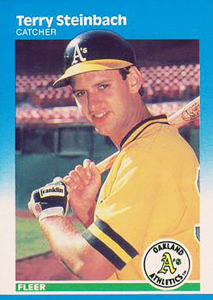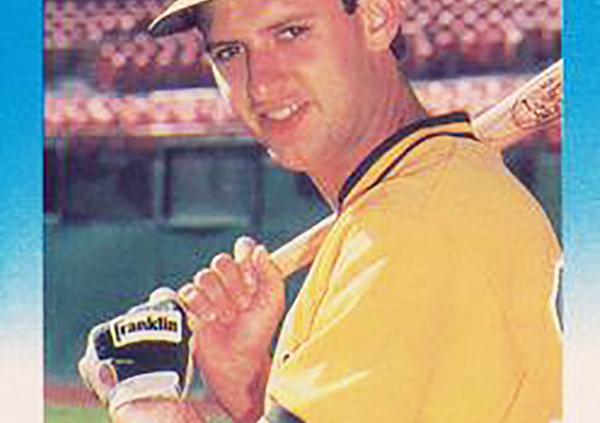September 12, 1986: Terry Steinbach’s home run in debut overshadowed as Cleveland beats Oakland, 9-3
 Minnesota is known for town-team baseball, and one of its cities, New Ulm in the southern part of the state, stands out. Two pitchers born in New Ulm were the first from the city to make the majors, Elmer “Doc” Hamann in 1922 and Fred Bruckbauer in 1961.1 Both share a distinction: Neither retired a batter and each has a lifetime undefined (infinity) earned-run average.
Minnesota is known for town-team baseball, and one of its cities, New Ulm in the southern part of the state, stands out. Two pitchers born in New Ulm were the first from the city to make the majors, Elmer “Doc” Hamann in 1922 and Fred Bruckbauer in 1961.1 Both share a distinction: Neither retired a batter and each has a lifetime undefined (infinity) earned-run average.
Another New Ulm-born player born around the time of Bruckbauer’s denouement eventually reversed the trend. Terry Steinbach was the youngest of three athletic boys to go along with a younger athletic sister. Older brothers Tim started college in Wisconsin, while Tom went to the University of Minnesota. Some suggested that Tom was getting playing time with the U of M Gophers as an incentive for Terry to join him the next season.
Nevertheless, Tom earned his keep on the team with his strong arm in right field and his surprisingly stronger hitting, setting school career records in several categories, including home runs. Terry followed him to Minnesota as did the other brother, Tim, who transferred to the Gophers after playing at the University of Wisconsin, River Falls. With Tom anchored in right field, Tim did the catching and Terry played third base.
Terry and Tom were drafted and signed – by the Athletics and Mariners respectively – in 1983.2 Tom’s pro career didn’t last long, and he returned to New Ulm and played for the local amateur teams for decades. Tim did not play professional baseball but continued in the sport as an umpire, often working Gophers games.
Terry, however, was the star of the bunch and progressed through Oakland’s farm system. He was switched to catcher after two seasons, with the Athletics sending him to the Arizona Instructional League to learn the position. He played for Huntsville in the Double-A Southern League in 1985 and 1986, hitting 24 home runs and driving in 132 runs the latter year. He received the league’s Most Valuable Player Award in 1986, earning him a summons to the A’s when the Southern League playoffs ended. “I was still working on my catching … but I guess the A’s thought I’d improved enough behind the plate to take a look at me on the major league club and I was called up in September,” Steinbach said.3
On September 12, 1986, the Athletics were clinging to third place, a half-game ahead of Kansas City and 14½ games behind the first-place California Angels, when they opened a weekend series in Cleveland. Mickey Tettleton was behind the plate for the A’s, catching Bill Krueger, who had a 1-1 won-lost record, the same as Cleveland starter Greg Swindell. Krueger was in his seventh year of pro ball and fourth in the majors. A tall southpaw like Krueger, Swindell had been the second overall pick in the 1986 draft, making the jump to the majors after only three games in Class-A ball.
Like Oakland, Cleveland was winding down the season with no hope of a pennant chase. The Athletics grabbed the lead in the game with two out in the first on a solo homer by José Canseco, the 31st of the year for the player who would later be named the league’s Rookie of the Year. Cleveland tied it in the second when Joe Carter, after beating out an infield hit, scored from first on Canseco’s error on Cory Snyder’s double.
Krueger unraveled in the third, walking Otis Nixon and Julio Franco. With two out, Carter doubled for one run and two more came in on a double by Snyder. Krueger stuck around long enough to give up a two-run triple to Brett Butler in the fourth inning before being relieved by Eric Plunk. The score was 6-1, Cleveland.
The carnage continued in the fifth with Carter leading off with a double, stealing third, and scoring on a single by Pat Tabler, who also stole a base and came home on a double by Carmelo Castillo.
An unearned run in the top of the sixth – scored when Dusty Baker singled home Carney Lansford, who had reached on an error by Snyder at shortstop to start the inning – still left the Athletics trailing 8-2. Along the way, Oakland announcers posed a trivia question, asking, “Who had homered in his first at-bat for the Athletics?”4
Steinbach made his major-league debut in the bottom of the sixth, replacing Tettleton at catcher, and was the first batter up in the seventh. “When you’re playing your first game,” Steinbach told Al Doyle of Baseball Digest in 2005, “you’re just hoping not to embarrass yourself.”5 He didn’t. Steinbach worked the count full, stayed alive with a couple of foul balls, and then lined a Swindell pitch over the left-field fence, a feat that required the Oakland broadcast crew to update the answers to their trivia quiz.
Cleveland answered Steinbach’s blast in the bottom of the seventh as Carter walked to reach base for the fourth time. He stole second and scored his fourth run of the game on a two-out single by Brook Jacoby.
The scoring ended there, and Frank Wills ended up pitching the last two innings in relief of Swindell, who left the game with tenderness in his left elbow. The team later known as the Guardians won 9-3.
“We lost the game, but hitting a homer in my first big-league game and first at-bat is a memory that will always stand out,” said Steinbach.6
Despite Steinbach’s memorable debut, the game’s star was Carter. He had a perfect night at the plate before flying out to end the eighth. His two stolen bases gave him 23 for the season, and he stayed close to Canseco for the American League lead in runs batted in – Canseco having 108 and Carter 104 after each drove in a run in the game. Carter eventually passed Canseco and led the league with 121 RBIs that season.
In addition to his bat-and-base speed achievements, Carter used his arm to defuse an Oakland rally in the fourth. With the bases loaded, Carter caught Tettleton’s fly and gunned out Dave Kingman at the plate to end the inning. Carter finished ninth in the balloting for Most Valuable Player that year, his first of four top-10 MVP finishes.
The Cleveland win was the first of 15 in its final 22 games of the season, securing a won-lost record of 84-78 that was still only good enough for a fifth-place finish in the seven-team American League East Division. In contrast, playing in the weaker West Division, Oakland was able to finish in a third-place tie with a 76-86 record.
The Athletics improved the next year, and starting in 1988 won the division title four of the next five years, producing two American League pennants and one World Series championship.
Steinbach worked his way into being Oakland’s starting catcher in 1987 and he held the spot for 10 years. He made the All-Star team in 1988 and 1989. In his first All-Star Game plate appearance, he homered off Dwight Gooden, becoming the first player to homer his first time up in both the regular season and in the All-Star Game.
In late 1996, Steinbach returned home, signing as a free agent with the Minnesota Twins. He played his final three seasons in the majors with his home-state team. He came full circle with a return to amateur baseball to play for a few more years. Then he used his insights and experience to help coach teams from the high-school to major-league levels.
Sources
In addition to the sources cited in the Notes, the author consulted Baseball-Reference.com and Retrosheet.org for box scores and play-by-play.
https://www.baseball-reference.com/boxes/CLE/CLE198609120.shtml
https://www.retrosheet.org/boxesetc/1986/B09120CLE1986.htm
Photo credit: Terry Steinbach, Trading Card Database.
Notes
1 While Hamann was a New Ulm legend, Bruckbauer was a star in nearby Sleepy Eye. However, he had been born in New Ulm.
2 Two other New Ulm players were drafted in 1983, Jeff Schugel and Doug Palmer, who both played in the minor leagues.
3 Terry Steinbach as told to George Vass, “The Game I’ll Never Forget,” Baseball Digest, December 1991: 85.
4 Kit Stier, “A’s Rookie Debuts With Homer,” Oakland Tribune, September 13, 1986: D1, D4. The players, at the time the question was asked, were Gene Hasson in 1937 (although apparently the broadcast crew omitted him from their answer), Clarence “Ace” Parker in 1937, Bert “Campy” Campaneris in 1964, and Joe Keough in 1968. (Parker did even better in a different sport and is a member of the Pro Football Hall of Fame.)
[5] “The Game I’ll Never Forget,” 78.
[6] “The Game I’ll Never Forget,” 78.
Additional Stats
Cleveland Indians 9
Oakland Athletics 3
Cleveland Stadium
Cleveland, OH
Box Score + PBP:
Corrections? Additions?
If you can help us improve this game story, contact us.


